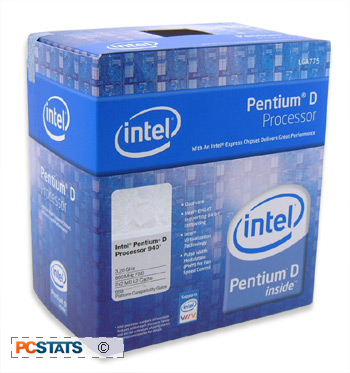The Intel Pentium D 940 ships in a distinctive blue box,
differing from the orange colour scheme that has typified recent Pentium 4
processors. The details of the chip are printed on the side of the box as usual. Note
that Intel has kindly offered a warning confirming that this CPU works best with
an Intel Express chipset, no mention of nVidia nForce 4 SLI Intel Edition here...
surprise, surprise.
 The processor we tested was ATX motherboards, as are the
majority of dual-core Pentium D's for sale. Intel seems to have put BTX on the
back-burner for a little while, which is probably a sensible decision on its
part.
The processor we tested was ATX motherboards, as are the
majority of dual-core Pentium D's for sale. Intel seems to have put BTX on the
back-burner for a little while, which is probably a sensible decision on its
part.
The Pentium D 940 itself is practically
identical to previous LGA 775 Pentium processors, having the characteristic integrated heat-spreader and
flat, gold contact-point covered underside (pinless). The array of resistors and
capacitors in the center of the processor's underside remains, and these are as
vulnerable to damage as ever, so be careful.
The installation procedure is identical to
other LGA 775 socket Pentium processors, with the usual warnings about
protecting the pins on the motherboard. If you'd like more information about the
installation procedure, see PCSTATS guide on the subject.
The heatsink that shipped with the processor is typical,
consisting of a large and mostly un-housed fan topping a hunk of copper-cored
aluminium extrusion. As we'd expect, the fan was quiet during operation and
altogether solid and unremarkable. Fan speed (and hence noise) is controlled by
way of the 4-pin Pulse Width Modulation power connector. This allows the
computer to sense how fast the CPU fan is spinning, and scale down
or speed it up depending on the case or processor temperature.
By automatically controlling the speed of the fan, noise can be limited
without sacrificing cooling.
Intel Pentium D 940 and Memory Speed
As you probably know, most recent Intel and AMD-based motherboards allow
users to alter the speed at which the system memory runs internally. This is
separate from the FSB (Front Side Bus) speed used to determine the bandwidth
between the processor and the rest of the system in that it affects only the
speed of the memory itself.
Decreasing internal memory speed below the default front side bus (FSB) speed can have dire
effects on performance, but increasing this value above FSB (for example using
DDR2-533 memory at its rated speed with an 800MHz FSB Pentium 4 processor) has
historically added little to benchmark scores. From PCSTATS early benchmarks using
the Intel Pentium D 940 though, it looks like that's going to change.
We discovered that if we ran a set of Crucial Ballistix DDR2 memory at 533MHz
as opposed to the default 400MHz FSB bus speed of the Pentium D 940/975X Express
test system, we gained a significant and noticeable performance increase to the
tune of ~5% on most benchmarks. Not bad.
This characteristic of the Pentium D makes sense if you analyze the way the
processor works. Both cores essentially compete for FSB and memory time, using
the same interface to do work as well as communicate with each other. The
Pentium D processors use the exact same 800MHz/400MHz FSB speed that single core
Pentium 4 processors do though. Given the increased demand placed on the memory,
it's not surprising that increasing its internal speed actually does pay
performance dividends.
Early looks then, suggest that buying the fastest DDR-2 memory you can
find is a good idea if you plan on investing in a Pentium D processor... so
start looking for PC2-8000 at least.
